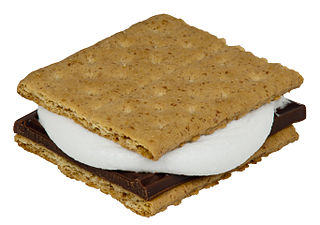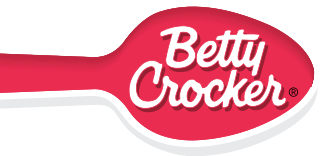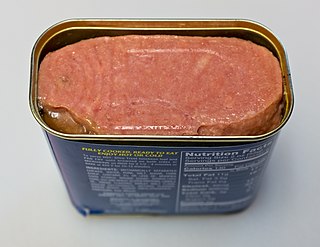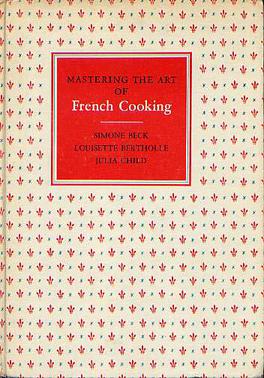
James Andrews Beard was an American chef, cookbook author, teacher and television personality. He pioneered television cooking shows, taught at The James Beard Cooking School in New York City and Seaside, Oregon, and lectured widely. He emphasized American cooking, prepared with fresh, wholesome, American ingredients, to a country just becoming aware of its own culinary heritage. Beard taught and mentored generations of professional chefs and food enthusiasts. He published more than twenty books, and his memory is honored by his foundation's annual James Beard Awards.

A cookbook or cookery book is a kitchen reference containing recipes.

A s'more is a confection consisting of toasted marshmallow and chocolate sandwiched between two pieces of graham cracker. S'mores are popular in the United States and Canada, and traditionally cooked over a campfire. In the realm of camping, s'mores are a staple dessert.

Betty Crocker is a brand and fictional character used in advertising campaigns for food and recipes. The character was originally created by the Washburn-Crosby Company in 1921 following a contest in the Saturday Evening Post. In 1954, General Mills introduced the red spoon logo with her signature, placing it on Gold Medal flour, Bisquick, and cake-mix packages. A portrait of Betty Crocker, first commissioned in 1936 and revised several times since, appears on printed advertisements and product packaging.
Sara Moulton is an American cookbook author and television personality. In an article for The New York Times, Kim Severson described Moulton as "one of the nation’s most enduring recipe writers and cooking teachers...and a dean of food television and magazines".

Treet is a canned meat product similar to Spam first introduced in 1939 by Armour and Company in the United States. Sold as "spiced luncheon loaf", it is made with chicken and pork and has a more finely ground texture than Spam, more akin to bologna or vienna sausages. Like Spam, it is often fried or baked before consumption. Treet is currently manufactured by Pinnacle Foods.

Depression cake is a type of cake that was commonly made during the Great Depression. The ingredients include little or no milk, sugar, butter, or eggs, because the ingredients were then either expensive or hard to obtain. Similar cakes are known as "War Cake", as they avoided ingredients that were scarce or were being conserved for the use of soldiers. A common depression cake is also known as "Boiled Raisin Cake", "Milkless, Eggless, Butterless Cake", or "Poor Man's Cake". "Boiled" refers to the boiling of raisins with the sugar and spices to make a syrup base early in the recipe. However, some bakers do include butter. Boiled raisin-type cakes date back at least to the American Civil War.

Mastering the Art of French Cooking is a two-volume French cookbook written by Simone Beck and Louisette Bertholle, both from France, and Julia Child, who was from the United States. The book was written for the American market and published by Knopf in 1961 and 1970.

Nitza Villapol Andiarena was a chef, teacher, cookbook writer, and television host in Cuba. She has been called, by some, the "Cuban Julia Child" for her ability to communicate culinary arts to a popular audience. Born in New York to Cuban immigrants, Villapol lived there until the age of 11, after the collapse of the Machado regime. It is unclear whether she studied nutrition at the University of London during the early 1940s, or if she attended Harvard and MIT in the 1950s, or whether she completed her doctorate degree in Havana in 1955. By the 1950s, Villapol was famous in Cuba for her standard cookbooks on Cuban cuisine Cocina al minuto (1950). From 1948 to 1997 she had her own cooking show on Cuban television, one of the longest-running shows in television Cuban history. After 1959, she sided with the revolution and remained a fixture in Cuban popular culture throughout her life. During Cuba's "Special Period" of the early 1990s, she managed to demonstrate on her show how to prepare traditional Cuban recipes under the difficult circumstances of rationing, poverty and shortages. Though she came from a wealthy background, her father identified himself as a communist, and gave her a Russian first name in tribute to the Russian revolution ; following in his footsteps, Villapol found an accommodation with Cuban communism and succeeded in winning over her audience by cooking within the limitations present during the existing socialist regime. She died in 1998 in Havana, Cuba.

Marjorie Husted was an American home economist and businesswoman who worked for General Mills and was responsible for the success and fame of the brand character Betty Crocker. Husted wrote Betty Crocker's radio scripts and was her radio voice for a time.

The Betty Crocker Cookbook is a cookbook written by staff at General Mills, the holders of the Betty Crocker trademark. The persona of Betty Crocker was invented by the Washburn-Crosby Company as a feminine "face" for the company's public relations. Early editions of the cookbook were ostensibly written by the character herself.

Vibration Cooking: Or, the Travel Notes of a Geechee Girl is the 1970 debut book by Vertamae Smart-Grosvenor and combines recipes with storytelling. It was published by Doubleday. A second edition was published in 1986, and a third edition was published in 1992. The University of Georgia published another edition in 2011. Smart-Grosvenor went on to publish more cookbooks after Vibration Cooking. Vibration Cooking raised awareness about Gullah culture. Scholar Anne E. Goldman compared Vibration Cooking with Jessica Harris' Iron Pots and Wooden Spoons, arguing that, in both books, "the model of the self... is historicized by being developed in the context of colonialism." Scholar Lewis V. Baldwin recommended Vibration Cooking for its "interesting and brilliant insights on the social significance of food and eating and their relationship to 'place' in a southern context." The book inspired filmmaker Julie Dash to make the film Daughters of the Dust, which won awards at the Sundance Film Festival.
Phila Hach — pronounced "File-ah Hah" was an American chef, restaurant owner, innkeeper, and caterer who authored 17 cookbooks, including recipe collections for the 1982 World's Fair, Opryland USA and Cracker Barrel restaurants. She has been called the "grand dame of southern cooking" and counted as good friends Duncan Hines and Julia Child. Hach catered functions for the United Nations, U.S. mayors and governors, military personnel and celebrities, and was the one of the pastry chefs at the wedding of Princess Diana.

Helen McCully (1902–1977) was a Canadian food writer, critic and cookbook author from Nova Scotia. She was influential as a food editor of McCall's and House Beautiful and was at least partially responsible for helping to discover the unknown Julia Child in 1960. Besides writing regular columns on food, she used her influence to help promote the careers of many in the food industry, as well as writing her own cookbooks.

Jessamyn Waldman Rodriguez is an accomplished social entrepreneur, educator, and hospitality executive with a deep passion for innovation and community-building. She is the Managing Director of the Jim Joseph Foundation, an organization dedicated to advancing Jewish education across North America. Jessamyn collaborates with visionary partners to develop, support, and incubate initiatives that promote growth and inclusivity.

How to Cook and Eat in Chinese is a cookbook and introduction to Chinese cuisine and food culture by Buwei Yang Chao. It was first published in 1945, and appeared in revised and expanded editions in 1949 and 1956; the third and final edition appeared in 1968. It has been called "the first truly insightful English-language Chinese cookbook", Much of the text was written by her husband, Yuen Ren Chao, who coined the commonly used English terms for Chinese cooking techniques such as "stir fry" and "pot stickers".
Barbara Haber is a culinary historian and speaker. She is the former book curator of the Schlesinger Library at Harvard University. Haber is credited with expanding the library's focus on women's social history to include food-related books and cookbooks, as well as fiction and memoirs, despite critics that were originally against it. She has authored and co-written books on subjects related to culinary history.

The Virginia House-Wife is an 1824 housekeeping manual and cookbook by Mary Randolph. In addition to recipes it gave instructions for making soap, starch, blacking and cologne.

How to Cook a Wolf by M. F. K. Fisher is an American cookery book and/or disaster survival guide and/or prose poem that was first published in 1942.


















